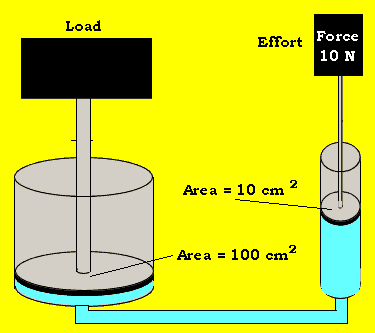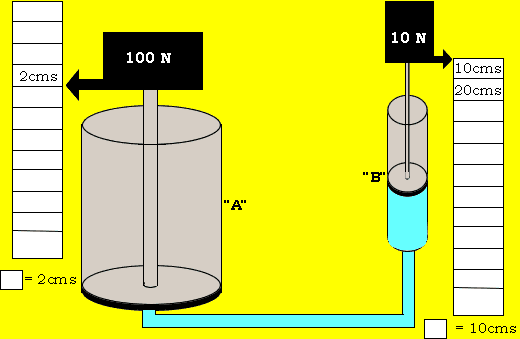Hydraulics
Multiplying forces

Challenge one of your friends to hold down the plunger of the large syringe while you press on the plunger of the smaller syringe. You will find you win every time. The force that is applied to the small syringe seems to be multiplied in the large syringe.
Pistons of different sizes can be used to magnify forces. Now how can this happen? It seems remarkable that we get something for nothing. Is this possible? No! You see the amount of work is the same. The work done in pushing the smaller piston down is exactly the work done in lifting the heavier weight up.
Consider the setup pictured
on the right. If a force of 10N is applied to the smaller piston it generates
a force of 100N to lift the load on the larger piston.
Note the different cross sectional areas of each piston. Pushing down
on the smaller piston with a force of 10N generates a pressure in the
liquid given by the expression below.
Pressure = force / Area = 10N/10cm2
Pressure = 1N/ cm2
This
means that a force of 1N acts on every square centimetre of exposed surface.
This pressure is transmitted through the fluid to the larger piston.
The large surface area of the other piston plays a critical role in multiplying
the force. Now remember that a force of 1N acts on every square centimetre
of exposed surface area. The larger piston with 100cm2 of exposed
area will have a force exerted on it according to the expression below.
Force = pressureXarea = 1N/cm2 X 100cm2
Force = 100N

Below is the animation of the two pistons operating together.

Look at the operation of the two pistons above of a 10N force being multiplied to become a 100N force. Notice how the smaller piston with a force 10N travels 20cms down the grid, while the larger pistons travels 2cms up the grid. Now lets calculate the work done by each piston.
Piston "A"
= Force X Distance = 100N X 0.02m = 2 Joules
Piston "B" = Force X Distance = 10N X 0.2m = 2 Joules.
Notice how the work is the same. The law of conservation of energy
("Energy can not be created or destroyed")
is not violated. The increase in force is compensated by a decrease in
distance travelled.